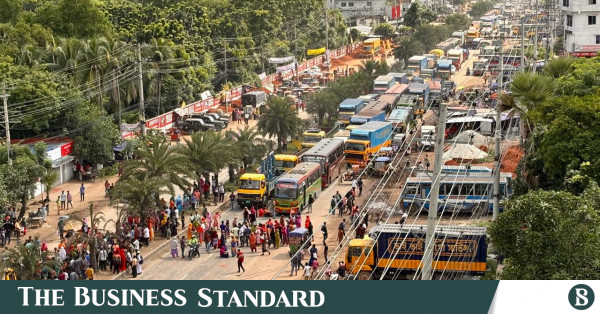Ashulia belt at the heart of RMG unrest – here’s why


The apparel industries located in Savar, Ashulia, and Zirani, on the outskirts of the capital Dhaka have become the main victims of the ongoing labour unrest, which has persisted for the past 15 days.
According to industry insiders, the unrest initially stemmed from internal issues at a few specific factories and has since escalated.
These factories, which were largely beneficiaries of the previous government, have often suspended wage increments over the past three years, paid management staff salaries irregularly, and failed to provide its staff with maternity and earned leaves.
These long-standing grievances have contributed to the current instability in the region, they added.
The unrest at NASSA Group’s factory was the starting point of the recent labour movement. A few days later, workers from NASSA Group launched attacks on several other major factories, including those belonging to Ha-Meem Group, Sharmin Group, Ananta Garments, Al Muslim, Beximco Group, Sterling Group, Envoy Group and Newage Group.
During this period, some factory owners attempted to exploit the situation to put pressure on the current board of the Bangladesh Garment Manufacturers and Exporters Association (BGMEA). Some of these factory groups were also involved in a separate movement calling for the board’s dissolution, according to industry insiders.
Several labour leaders, speaking on condition of anonymity, mentioned that some large factory owners tried to use their workers to gain leverage. However, they misjudged the situation, as the dynamics have shifted, and the movement quickly spiralled out of their control.
In the past, these factory owners were able to suppress such movements by relying on law enforcement agencies and leveraging their deep connections with political power or trade bodies like the BGMEA and the Federation of Bangladesh Chambers of Commerce and Industry.
“Now, the situation is different,” one of the labour leaders said, indicating that such tactics no longer work as effectively as they once did.
Speaking to The Business Standard, Awaj Foundation Executive Director Nazma Akhter said, “This is not an organised labour movement, as most of the demands focus on issues like tiffin bills, night allowances, and attendance bonuses.”
She emphasised that if it were a structured movement, the key demand would likely be wage adjustments to address inflation.
Nazma Akhter also noted that labour leaders in the Ashulia region are linked to local politics, primarily with the Awami League. However, she pointed out that the situation is different in other areas like Gazipur, where labour dynamics are distinct.
According to her, not only labour leaders but also some factory owners in Ashulia are heavily involved in Awami League politics, which may explain why some discontented workers have been drawn into the unrest.
According to industry insiders, about 220 labour associations are actively working in the RMG belt of Savar, Ashulia, and Zirani.
However, Garment Workers Trade Union Centre Vice President Joly Talukder said some politically motivated groups involved in the unrest are primarily factory owners.
She further noted that factories linked to the ousted political government face severe unrest due to unresolved issues and delays in payments.
“If these factory owners, who are either in hiding or in jail, want to resolve the issues, it can be done in a short time,” said Joly Talukder.
On Wednesday, a group of agitated workers from Beximco Industrial Park set fire to another factory owned by different people in the Gazipur area, she added.
Joly noted that while entrepreneurs do not agree with all of the workers’ demands, they do agree with some of them. The labour rights activist mentioned other demands, such as providing night shift allowances and ensuring on-time payment of monthly wages.
Labour leaders have said workers want to return to work, but local political issues have triggered the unrest.
Nazma Akhter mentioned that the trade in waste fabrics (jhut) is also influenced by political factors. Despite efforts to convince workers to return to work, she warned that the situation could ultimately yield negative results in every area, including the economy, factories, and workers.
Speaking to TBS, BGMEA Director Shovon Islam said, “The Gazipur and Bhaluka belts are in a better position as their factory owners have good relations with workers, which helps mitigate these issues.”
No signs of improvement in RMG unrest
The ongoing unrest in Bangladesh’s major industrial zones, including Savar, Ashulia, and Gazipur, shows no signs of abating and, in some cases, is deteriorating, according to the BGMEA.
On 12 September, amid the ongoing RMG workers’ protests, about 115 factories in Savar, Ashulia, and Gazipur were closed down, as reported by the BGMEA.
BGMEA Director Mohiuddin Rubel told TBS that of these, 75 factories were shut down in accordance with labour rules, allowing leave without pay for workers, while 44 factories announced closures with paid leave.
BGMEA sources confirmed that of the 115 closed factories, eight are in Gazipur, and 107 are in the Savar, Ashulia, and Zirani areas.
BGMEA President Khandoker Rafiqul Islam said the situation remained unchanged from Wednesday, despite factory owners agreeing to meet four major demands from workers. Factories were closed on Thursday, continuing the same status, with NASSA Garments also facing operational challenges.
He hoped that the situation might improve by next Saturday, as some labour leaders are working to resolve the issue.
Adviser to the Labour and Employment Ministry, Asif Mahmud Shojib Bhuiyan, is scheduled to meet with labour organisation leaders and factory owners on that day.
The BGMEA president noted that a key demand was that no workers would be blacklisted in the BGMEA database for their involvement in the protests, as being blacklisted would hinder their ability to secure future employment in other factories.
The BGMEA assured that no workers would face undue consequences.
Another demand related to the recruitment of more male workers. The BGMEA clarified that recruitment would be based on merit, without gender bias. Additionally, workers demanded an increase in their tiffin (snack) allowance, which currently ranges from Tk10 to Tk50 depending on the factory’s capacity. The BGMEA agreed to raise this allowance by Tk10.
However, the demand to increase the attendance bonus to Tk800 faced resistance, as smaller factories paying Tk400 could not afford this increase. Instead, the BGMEA agreed to add Tk225 to the current bonus amount.




